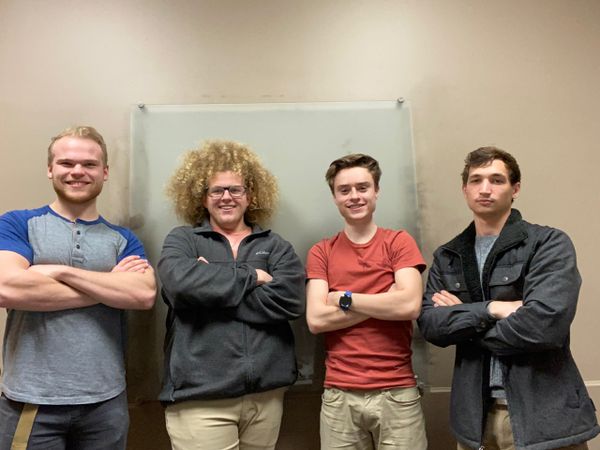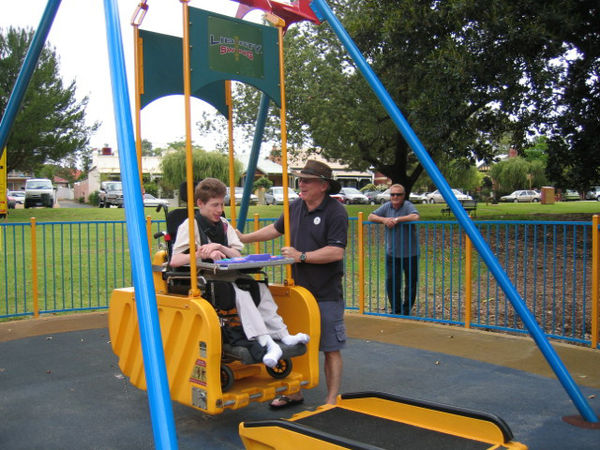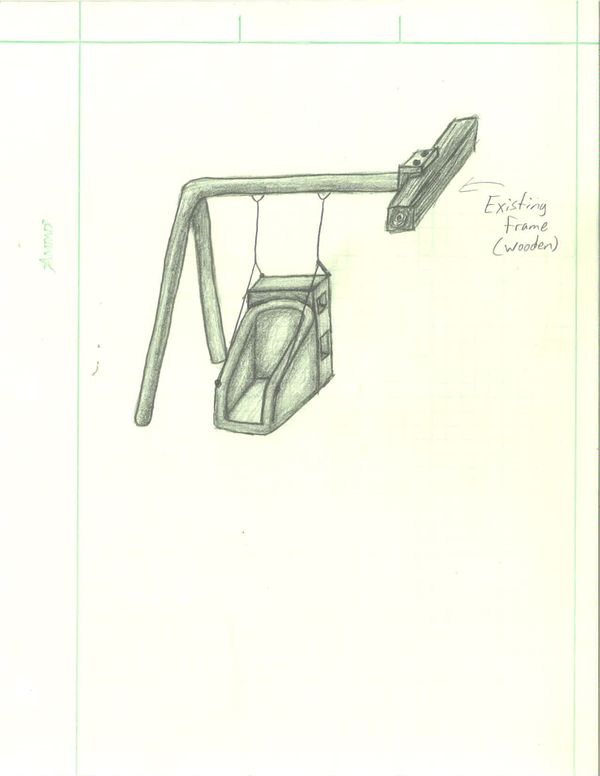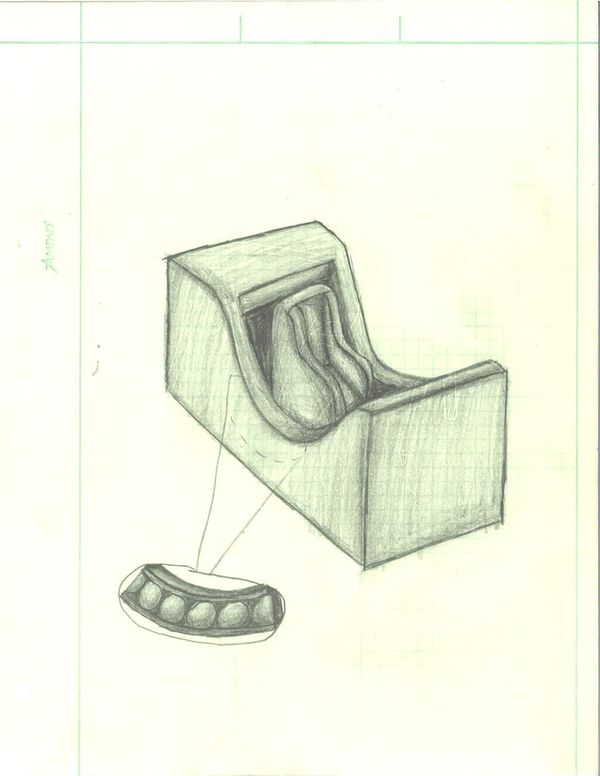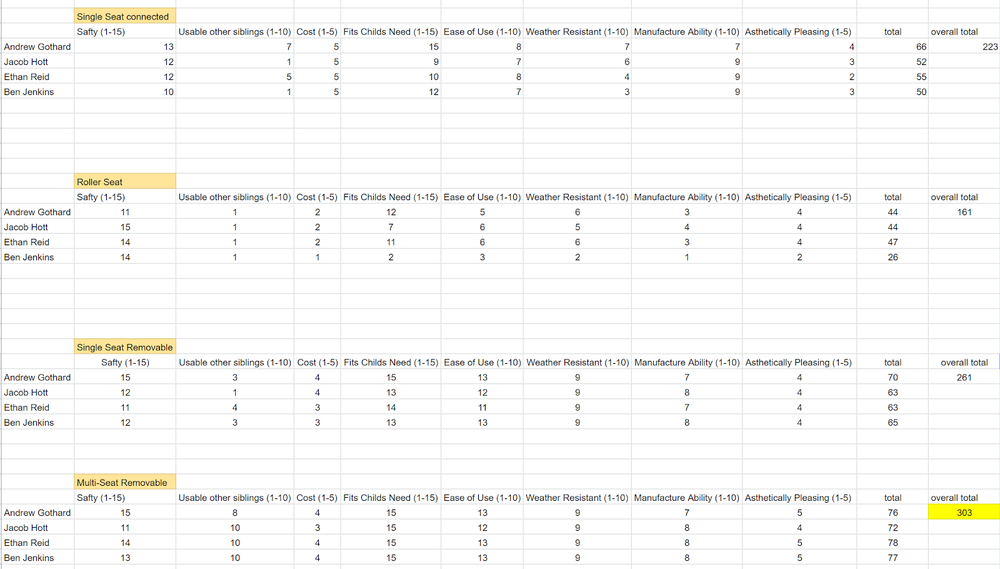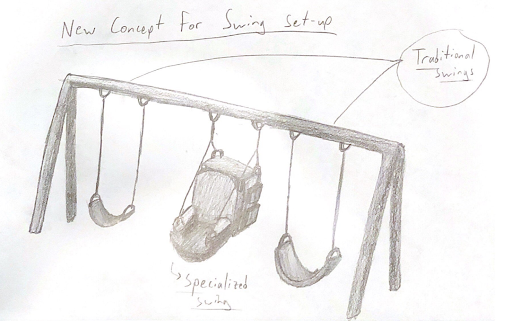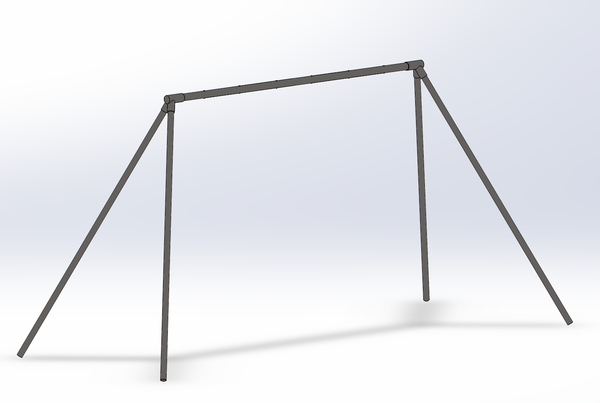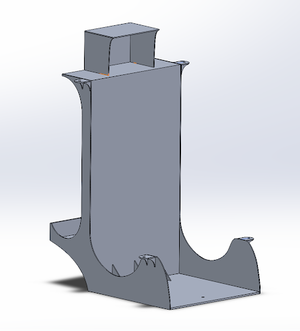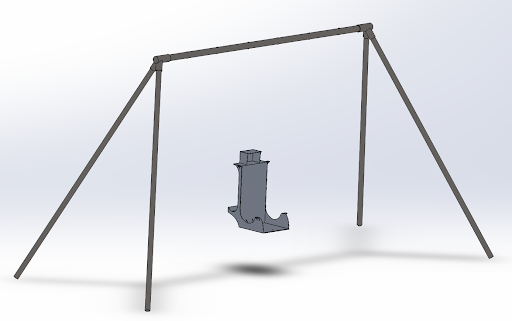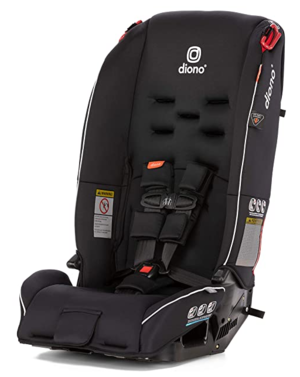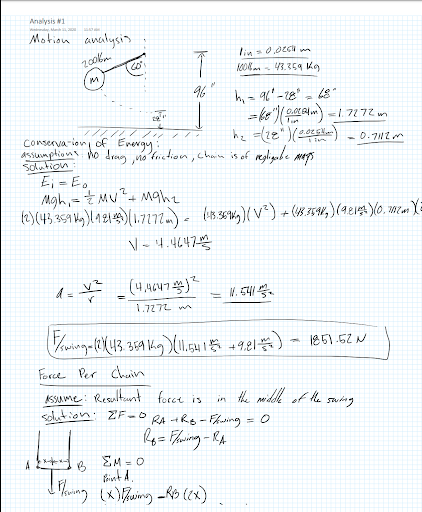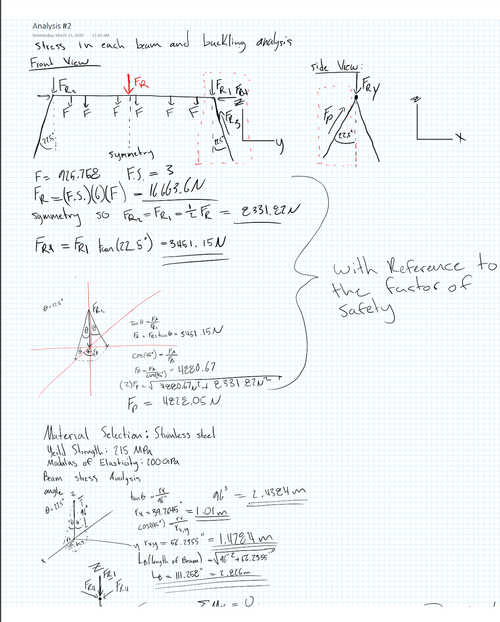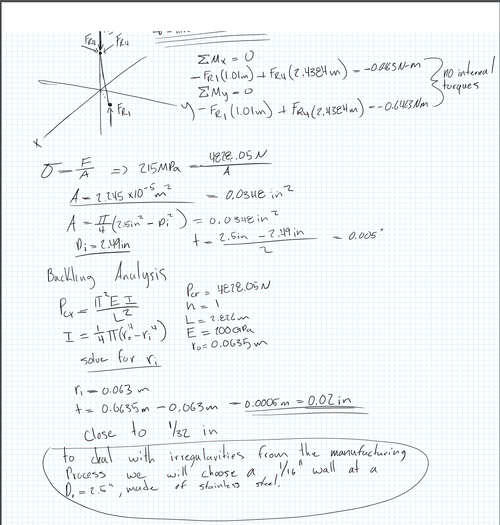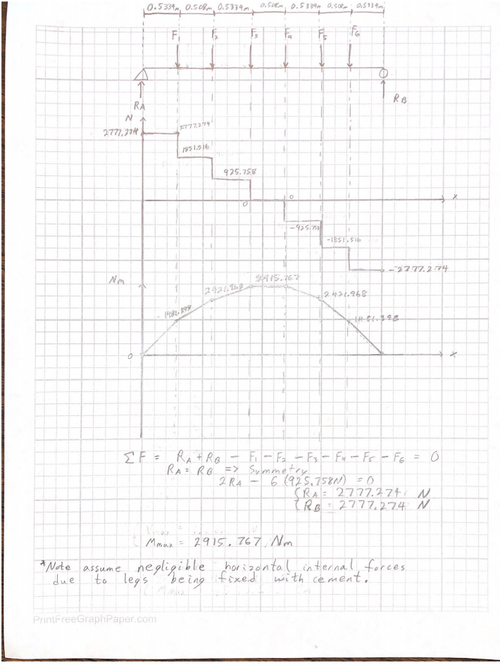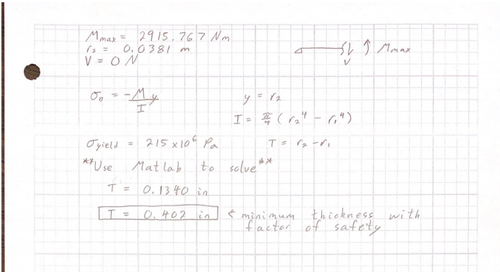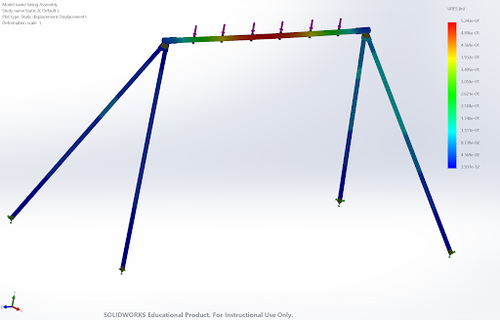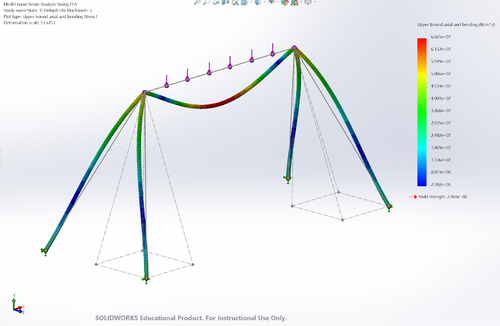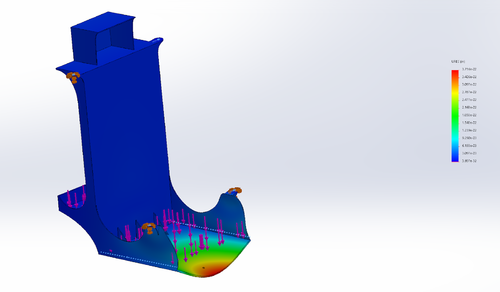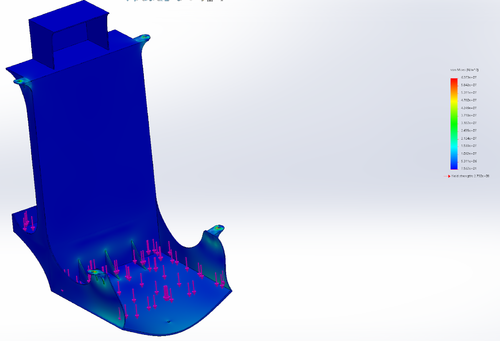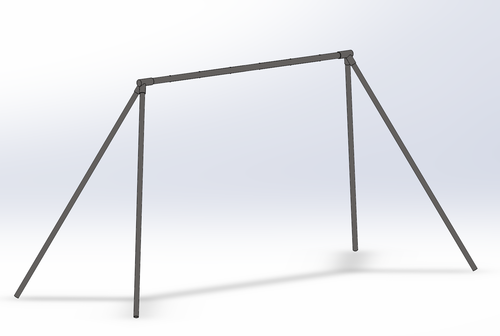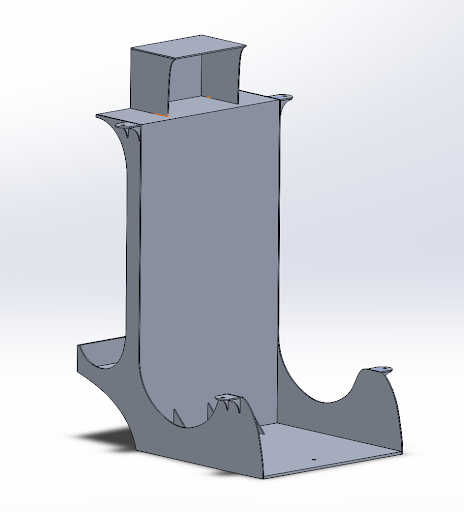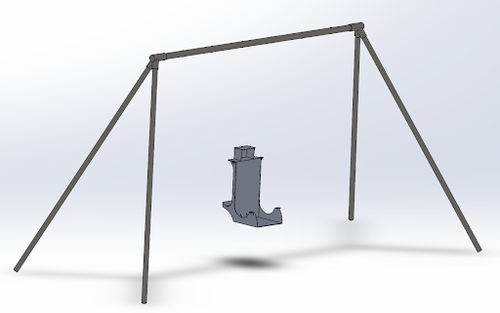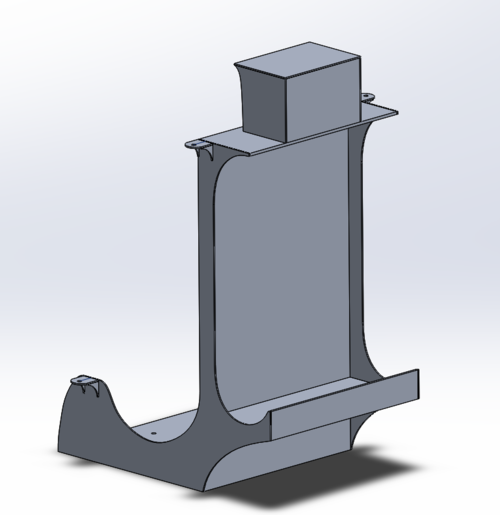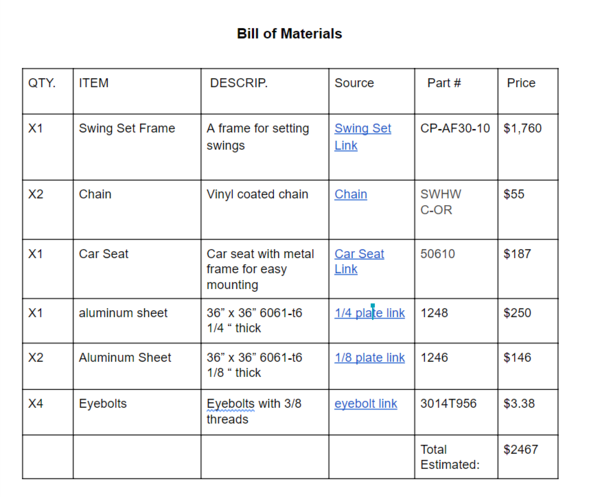Activity Chair
Abstract
Our client family has a 9 month old child named Ethan who has several cardiovascular and pulmonary problems that require him to constantly have machines to aid his breathing.
His family has requested for us to design and build a swing to accommodate his machines. It needs to fully support him while he is swinging, while also providing a space for his machines where his tubing will not get tangled.
Additionally, the family has asked that it be designed so that he can use it while he is growing for several years. To accommodate this we plan to build a swing seat that can hold all of his machines, with a detachable seat.
Team members
- Group members from left to right: Ethan Reid, Ben Jenkins, Andrew Gothard, Jacob Hott
Overview
The family is requesting a swing that can hold three types of medical equipment which are the pulsox, heart monitor, and joey pump.
These devices are used to monitor the baby’s (Ethan) breathing and oxygen levels and are required to be with him at all times.
The goal for this project is to provide Ethan with a swing that will help develop senses as he plays with his siblings.
Design Specifications
1. Must support the child's spine and head and allow him to stably sit up straight.
2. Must permit accommodations for the growth of the child, i.e. adjustable back.
3. Swing must be outside with the existing swing to allow the child to be around other children.
4. Swing must support the weight of a 9 month old as a minimum requirement, and the weight of a 3 year old as a possible maximum.
5. Must be weather resistant.
6. Must accommodate all electronic devices that the child requires, such as trach and ventilator units.
7. Must allow ease of access from house to swing.
8. Must remain stable on uneven terrain.
9. Seat frame must be padded for safety.
Background research
1. What exists already, similar products
Most of the similar products we found were for kids who required wheelchairs. These swings included a platform for the wheelchair, which allowed the chair and kid to be strapped down while swinging.
We were not able to find any specific swings that could accommodate infants with cardiovascular and pulmonary issues. Products typically look like the following:
2. availability
We were not able to find any specific swings that could accommodate infants with cardiovascular and pulmonary issues.
3. identify gaps in existing products or technology to be addressed
existing products are often too large for infants and will not safely maintain their required equipment.
Conceptual Design
We wanted to design around the idea of ease of use and stability. Thus, we designed different forms of "swinging" mechanisms that could provide the necessary design specifications.
Additionally, we are considering the different kinds of chains we could potentially use to support the swing from the frame.
Design Concept 1
For this design, we considered utilizing the existing swing frame that the family already has in the area.
The swing frame would attach via a clamp of some kind.We do not think this design would be best, considering the potential instability in the existing frame.
It would be preferable to build our own frame and have it belong as a separate entity in the event that the family wants to get rid of the older swing set.
Design Concept 2
For this design concept, we went with a less traditional "swing" design, more akin to a slide. This design would likely require the use of a motor to pull and push the child in a swing-like motion.
This design is beneficial in that it is one of the safest designs we could come up with. However, the utilization of the motor could create higher expenditure costs unnecessarily.
Thus, although it is better than Design Concept 1, it could definitely use some tweaking.
Design Concept 3
For this design, we went with a more traditional swing idea. The seat of the swing will have a "backpack" of sorts that allows for the placement of all of the child's necessary life support devices.
Although initially, we were concerned that weight may be an issue, we found that by placing the chain in the locations shown below, we can greatly decrease the likelihood of the chair flipping.
Additionally, different chain choices are shown as well, including a traditional chain, some sort of bar mechanism, and a bicycle chain system.
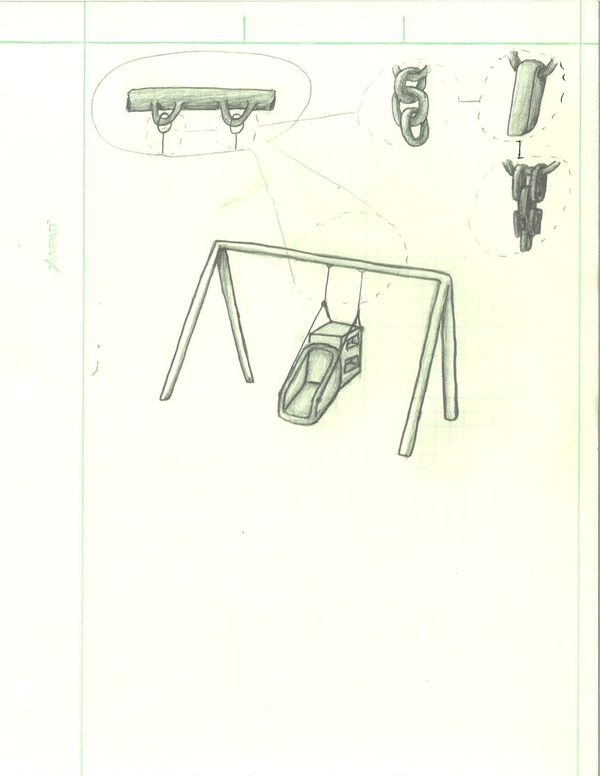
Design Concept 4
After consulting with Dr.Canfield and the family we decided to add two additional swings to promote interaction with his siblings.
This swing set will also be separate from the other existing swing set while retaining the same design concepts as concept three.
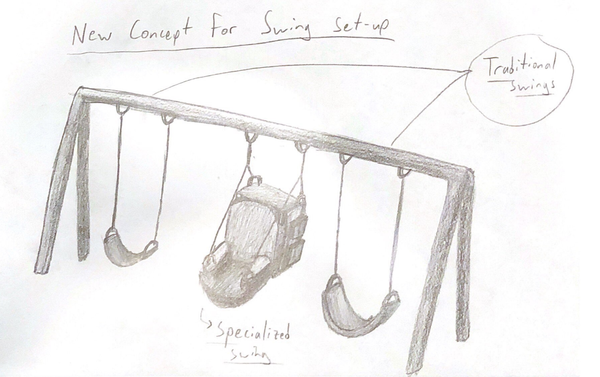
Evaluate concepts/select candidate
For our decision, each group member voted in the 8 categories shown above in the chart above. Based on our evaluation the balance of the safest, most beneficial, and longest-lasting swing would be based around the fourth design.
This design was chosen because it allows Ethan to interact with his siblings, but the swing will still be able to support all of their weight and will not be dependent upon the condition of the family's original swing set.
Detailed Design
This section will describe a detailed design process
Description of selected design
We chose the multi-seat, removable design since it introduces the use of 3 seats in total: one specialized seat for the child with medical disabilities, and 2 external seats for use by either other children or adults who wish to play with the child. We felt that this would provide the family with the best combination of social engagement, and safety while in use.
The following models depict a structural base for which a specialized chair will be attached, forming a stable swing set. The center-most seat will be specially designed for the child’s specific limitations, while the outermost seats will be for other children/adults to use. This will allow the child to experience social stimulation while also engaging his sensory skills.
The specialized seat will incorporate the use of a car seat for stability, with an outer “skeleton” to provide easy removal of the car seat. This is specifically required to ensure no weather damage occurs on the seat’s exterior. The “skeleton” will also include shelving for all necessary equipment, having dimensions appropriate for said equipment.
Detailed description of selected design
This design includes a swing set frame that will stand at approximately 96" tall and 12' in length. each leg is angled 22.5 degrees in both the z-y plane and the z-x plane.
The frame will be made of 304 stainless steel tubing, with a cross beam thickness of 5/16" and leg thickness of 1/16". We, however, would have opted to buy an existing safety rated swing due to the cheaper pricing.
For the seat, we decided it would be best to make it out of 1/8" and 1/4" aluminum. This would allow the frame to remain relatively light while retaining structural integrity. The frame would be connected to the frame with a set of I-bolts and chains.
Analysis
Describe three types of analysis to be performed on the design
Engineering analysis 1 (Dynamic Force Design):
In this design we determined the maximum force that would be produced at each connection point between the chains for each swing and the upper beam of the swing set.
This was done using a combination of a conservation of energy and centripetal force calculation. It was determined that the maximum force per chain would be approximately 925 N for three 200 lbf people swinging from a 60 degree angle.
Engineering analysis 2 (Buckling Analysis)
In this analysis we used a static structural buckling calculation in order to determine the wall thickness required for the legs of the swing set.
The estimated thickness from this hand calculation came out to be approximately one sixteenth of an inch with a diameter of 2.5 inches.
Engineering analysis 3 (Beam Analysis)
For our third analysis we did a beam analysis. We first calculated the shear and moment diagram in order to find the maximum moment.
Once we found this moment we used a bending analysis as shown by the second image in order to obtain an equation to calculate the minimum wall thickness needed to support the previously calculated maximum force.
Once this equation was obtained the MATLAB code below was used in order to find the minimum wall thickness, which was 0.402 with a factor of safety of 3.
Engineering analysis 4 (FEA of Swing Frame)
We used Solidworks to run FEA on a swing set frame in the case that we would have to build one. The first FEA model was performed with a solid body mesh.
However, since the wall thicknesses on the swing set were relatively thin in order to improve mesh quality and prevent nodes from collapsing.
For the second analysis, we improved our accuracy by moving into a beam analysis for the entire swing set. Once we did this we found a maximum deflection of 0.4” and minimum FOS of 3.
This was with a 3” OD 5/16” thick top beam and 2.5” OD 3/16” thick legs. The simulation was performed with 304 Stainless steel.
Engineering analysis 5 (FEA of Seat Frame)
For this analysis we ran a simple solid body mesh analysis on our seat frame, accounting for a 100lbm kid and roughly 2g’s.
We also accounted for the heaviest piece of equipment which was about 15lbm. Accounting for gravity the resultant force was 200lbf and 30 lbf.
This analysis found a minimum factor of safety of 4.315. The simulation was performed with 6061-T6 aluminum.
CAD Drawings
Insert drawings of all parts and the assembly
Bill of Materials
qty, item, description, source, part number, price
Sources:
Predicted Assembly Instructions
1. To start you would want to build the pre-fabricated swing set using the included instruction manual, without installing the middle swing set.
2. Next, you will want to install the middle pipe collets onto the cross beam.
3. Then, install the four I-bolts onto the swingset frame.
4. Now connect two chains to each collet for the middle swing.
5. Finally, connect each chain to one I-bolt in the desired forward position.
6. To attach the seat, set the seat down on the dowel towards the front of the frame and use the strap to fasten the seat into place.
Fabrication Process, Testing and Implementation, and Photos of Finalized Project -- Not Completed Due to COVID-19 --
Due to the Covid-19 Pandemic, our team was unable to meet in order to complete the project.
Given the circumstances, we were unable to fabricate any of the necessary parts, and thus, were unable to move forward.
Design Ideas for a Team Going Forward
1. Order the swing set frame to lower the cost.
2. Make sure to use some type of stainless steel or corrosion-resistant material for the seat frame.
3. include additional swings for Ethan's siblings.
4. Confirm equipment orientation with the family.
5. family discussed a possible wagon to pair with the cart seat.
6. stabilization feet to be cemented in the ground.
7. Padding along chains and seat frame.
Project Summary, Reflection
We were not fully able to provide this swingset for Ethan, but we believe we provided several things.
We were able to provide some hope for the family as the mother responded after we adressed the fact of not being
able to complete the swing "we are thankful for your impact on Ethan for what you could do", and we had the
opportunity to design a simple mechanism that can impact many families in the future.
Contact Information
To whomever picks up this project after us, please feel free to contact us!
We are all super invested, and are more than happy to help in any way we can.
Just send us a text and/or email, and we'll get back with you!
- Andrew Gothard, 931-544-0895, atgothard42@students.tntech.edu
- Jacob Hott, 931-561-1109, jwhott42@students.tntech.edu
- Ben Jenkins, 615-962-5693, btjenkins42@students.tntech.edu
- Ethan Reid, 615-670-8530, ejreid42@students.tntech.edu
